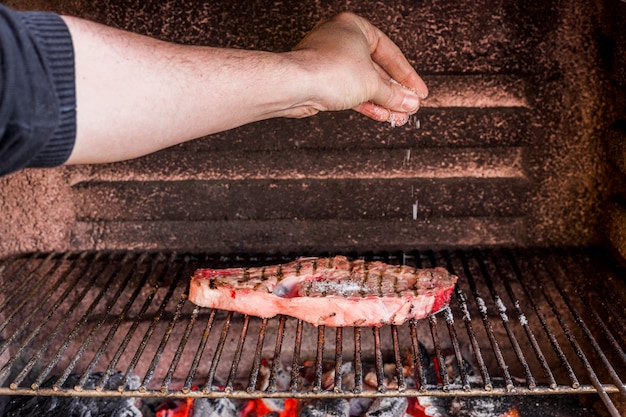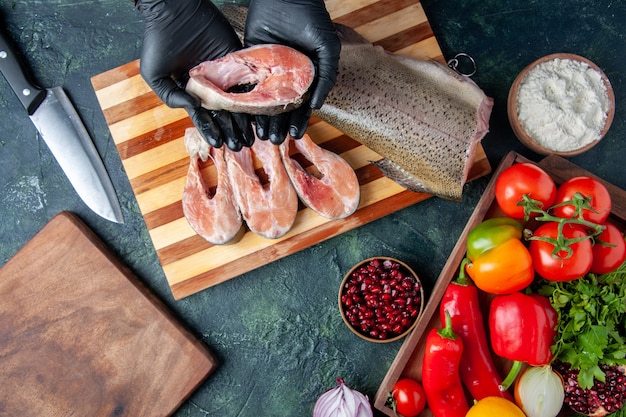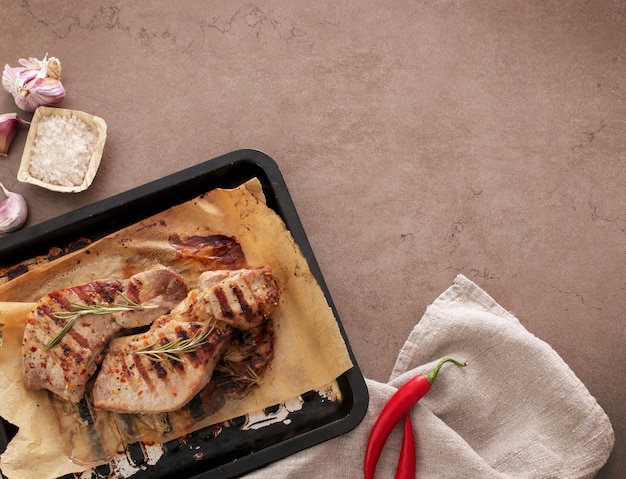Choosing Your Cut

Before we even think about ovens and temperatures, we need to pick our pork cut. There are tons to choose from, each with its own unique characteristics and best uses. I'm a sucker for a classic shoulder joint, it's juicy, full of flavour, and oh-so-versatile. For a more elegant dinner, a loin roast is hard to beat – leaner, cooks quicker, and perfect for special occasions.
Let's break down some of the most popular pork cuts:
Shoulder
The pork shoulder is a true workhorse. It's incredibly versatile, budget-friendly, and packs a punch when it comes to flavour. Think juicy roasts, hearty slow-cooked meals, or even pulled pork for sandwiches. It's the ultimate comfort food cut.
Loin
The loin is a leaner cut, ideal for roasting, grilling, or even making chops and steaks. It's a good option for those who prefer less fat, and it cooks relatively quickly, making it perfect for weeknight dinners.
Belly
pork belly is a fatty, flavourful cut, perfect for slow cooking and rendering down for delicious lard. It's also the star ingredient for bacon, and when roasted, it develops a beautiful crispy crackling.
Leg
A whole leg of pork is a real showstopper, perfect for a special occasion. It's often roasted whole, but you can also use it for chops or steaks. It's a larger cut that requires longer cooking time, but the results are well worth the wait.
spare ribs
Spare ribs are a classic bbq favourite, perfect for slow cooking and grilling. They're known for their tender meat and delicious, smoky flavour.
Baby back ribs
baby back ribs are smaller and leaner than spare ribs, perfect for grilling or smoking. They have a more delicate flavour and are often considered more tender than spare ribs.
Other Options
Don't be afraid to explore other cuts. You can find pork tenderloin, which is great for quick cooking, and even pork chops, which are perfect for a simple weeknight meal. The world of pork is your oyster!
The Importance of Temperature

Now, let's talk about the real key to successful pork cooking – temperature. We're not just talking about the oven setting, but also the internal temperature of the meat itself.
You see, cooking pork to the right temperature ensures it's safe to eat and also prevents it from drying out. Nothing worse than a dry, tough piece of pork, right?
The magic number for pork is 145°F (63°C). This is the internal temperature you're aiming for to ensure it's cooked through and safe to eat. We'll explore that in more detail later.
Cooking Pork in the Oven

Alright, the oven is your trusty sidekick in this pork-cooking adventure. But before you start cranking up the heat, remember that oven temperatures can vary depending on the type of oven you have.
To figure out the ideal temperature for your pork, you need to consider the cut you've chosen and the method you're using.
Preheating: The Essential Step
A good rule of thumb is to preheat your oven to 350°F (175°C) for most pork roasts. This creates a nice, even heat, which helps the meat cook evenly and develop a lovely crust.
Monitoring the Temperature
Now, you'll need to keep a close eye on the temperature throughout the cooking process. This is where a trusty meat thermometer comes in handy.
Insert the thermometer into the thickest part of the meat, making sure it doesn't touch any bone. You want to be sure that the meat reaches the safe internal temperature of 145°F (63°C).
Oven Temperatures for Different Cuts
Here's a handy table summarising the ideal oven temperatures and cooking times for different pork cuts:
| Cut | Oven Temperature (°F) | Cooking Time (per pound) |
|---|---|---|
| Shoulder | 325-350 | 1.5-2 hours |
| Loin | 350-375 | 1-1.5 hours |
| Belly | 300-325 | 2-3 hours |
| Leg | 325-350 | 2-3 hours |
| Spare Ribs | 275-300 | 3-4 hours |
| Baby Back Ribs | 250-275 | 2-3 hours |
Remember, these are just guidelines, the actual cooking time may vary depending on the size of your cut and your oven. Always check the internal temperature to ensure the meat is cooked through.(Part 2)
Mastering the Art of pork roasting
So, you've chosen your cut, preheated your oven, and you're ready to get roasting. Let's dive into a few essential tips that'll help you achieve pork perfection:
Seasoning Your Pork
Before you pop the pork in the oven, give it a good seasoning. Salt and pepper are the classics, but feel free to get creative! I love adding herbs like rosemary, thyme, and sage for a lovely aroma and flavour. You can also use rubs or marinades for an extra burst of flavour.
The Importance of Fat
Pork is naturally quite fatty, and that's a good thing! The fat helps to keep the meat moist and juicy during cooking. However, if you're using a leaner cut, it's a good idea to add some extra fat, like bacon or butter, to prevent it from drying out.
Achieving Crispy Crackling
Ah, the coveted crackling! There's nothing like a crispy, crackling crust. Here's how to achieve it:
- Score the skin of the pork with a sharp knife, making shallow cuts about half an inch apart.
- Rub the skin with salt and leave it uncovered in the fridge for at least 2 hours, or even overnight.
- When you're ready to roast, place the pork in the oven, fat side up.
- After about 30 minutes, pour boiling water over the skin to help it crisp up.
- Continue roasting until the crackling is golden brown and crispy.
Don't Be Afraid to Rest
Once your pork is cooked through, it's crucial to let it rest for at least 10 minutes before carving. This allows the juices to redistribute throughout the meat, making it even more tender and juicy.
Cover the roast loosely with foil to keep it warm while it rests.
Cooking Pork at Lower Temperatures
Sometimes, you want to cook your pork at a lower temperature, especially for cuts like shoulder or belly. This slow, gentle cooking helps to break down the connective tissue and render the fat, resulting in incredibly tender and flavorful meat.
For a slow roast, aim for an oven temperature of 250°F (120°C) and cook for a longer period of time.
Using a dutch oven
A Dutch oven is a fantastic tool for slow roasting. It helps to create a moist, even heat environment, perfect for breaking down those tough cuts.
To slow roast in a Dutch oven, preheat the oven to 250°F (120°C). Season your pork and place it in the Dutch oven. Add some liquid, like broth or water, to the bottom of the oven to prevent the meat from drying out. Cover the Dutch oven and cook until the pork is tender and reaches an internal temperature of 145°F (63°C).
Pork Perfection: A Few More Tips
Here are a few more tips to help you achieve pork perfection:
- Use a meat thermometer to ensure your pork is cooked through.
- Don't overcrowd the oven when roasting pork. Leave some space around the roast to allow for even heat circulation.
- Basting the pork with pan juices or broth during cooking can help to keep it moist.
- For extra flavour, try adding some vegetables to the roasting pan, like onions, carrots, or potatoes.
- Don't overcook your pork. Overcooked pork will be dry and tough.
- Rest your pork for at least 10 minutes before carving.
- Serve your pork with your favourite sides, like roasted vegetables, mashed potatoes, or a simple green salad.
Pork Cooking Temperatures: A Detailed Guide
Now, let's dive deeper into the world of pork cooking temperatures. Remember, the internal temperature is what matters, but the oven setting plays a crucial role in achieving that perfect internal temperature.
Safe Internal Temperatures: A Must-Know
The USDA (United States Department of Agriculture) recommends cooking pork to an internal temperature of 145°F (63°C). This temperature ensures that any harmful bacteria are killed, making the pork safe to eat.
But it's not just about safety. Cooking to the right temperature also ensures your pork is tender and juicy.
How to Use a Meat Thermometer
A meat thermometer is an essential tool for any pork cook. It helps you monitor the internal temperature of the meat and ensure it's cooked through.
Here's how to use a meat thermometer correctly:
- Insert the thermometer into the thickest part of the meat, making sure it doesn't touch any bone.
- Leave the thermometer in the meat for about 10 seconds to get an accurate reading.
- The internal temperature should reach 145°F (63°C) for safe consumption.
Adjusting Oven Temperatures for Different Pork Cuts
The oven temperature you choose will depend on the cut of pork you're cooking. Here's a breakdown:
Shoulder
A pork shoulder is a tougher cut that benefits from slow cooking at a lower temperature. Aim for an oven temperature of 325°F (160°C) and cook for 1.5-2 hours per pound.
Loin
A pork loin is a leaner cut that can be cooked at a higher temperature. Aim for an oven temperature of 350°F (175°C) and cook for 1-1.5 hours per pound.
Belly
Pork belly is a fatty cut that benefits from slow cooking at a lower temperature. Aim for an oven temperature of 300°F (150°C) and cook for 2-3 hours per pound.
Leg
A whole leg of pork is a larger cut that benefits from slow cooking at a lower temperature. Aim for an oven temperature of 325°F (160°C) and cook for 2-3 hours per pound.
Spare Ribs
Spare ribs are best cooked low and slow. Aim for an oven temperature of 275°F (135°C) and cook for 3-4 hours.
Baby Back Ribs
Baby back ribs are smaller and leaner than spare ribs, so they can be cooked at a slightly higher temperature. Aim for an oven temperature of 250°F (120°C) and cook for 2-3 hours.
The Importance of Resting
After your pork is cooked through, it's important to let it rest for at least 10 minutes before carving. This allows the juices to redistribute throughout the meat, making it more tender and juicy.
Cover the roast loosely with foil to keep it warm while it rests.
FAQs: Answering Your Pork-Cooking Questions
I know you might still have some questions about cooking pork, so here are some common ones and their answers:
1. What if my pork is overcooked?
If your pork is overcooked, it will be dry and tough. There's not much you can do to fix this, but you can try to salvage the meat by shredding it and using it in a dish like pulled pork.
2. What's the difference between a meat thermometer and a probe thermometer?
A meat thermometer is used to measure the internal temperature of meat, while a probe thermometer is used to monitor the temperature of an oven or smoker.
3. What's the best way to carve a pork roast?
When carving a pork roast, use a sharp knife and cut against the grain of the meat. This will help to make the meat more tender.
4. Can I cook pork in a slow cooker?
Yes, you can definitely cook pork in a slow cooker. It's a great way to achieve tender and flavorful meat.
5. What's the best way to store leftover pork?
Store leftover pork in the refrigerator in an airtight container for up to 3-4 days. You can also freeze leftover pork for up to 3-4 months. (Part 4)
Pork Cooking Beyond the Oven
Okay, so far we've been focusing on oven-roasting, but the world of pork cooking is much more expansive! Let's explore other fantastic methods, each offering its own unique flavour and texture.
Grilling Pork: Outdoor Delights
Nothing beats grilling pork on a sunny day, with the smoky aroma filling the air, and the crackle of the flames. But grilling pork requires some finesse to avoid dry, tough meat.
Here's how to grill pork like a pro:
- Choose the right cut: Thin cuts like pork chops or tenderloin are perfect for grilling, while thicker cuts like shoulder or belly are better suited for slow cooking.
- Marinade: Marinade your pork for at least an hour, or even overnight, to infuse it with flavour and keep it moist.
- Preheat your grill: Get those coals glowing hot, or heat up your gas grill to medium-high.
- Cook over indirect heat: Once the grill is hot, move the pork to a cooler part of the grill, away from direct heat.
- Monitor the temperature: Use a meat thermometer to ensure the pork reaches an internal temperature of 145°F (63°C).
- Rest: Let the pork rest for 5-10 minutes before slicing and serving.
Slow Cooking: The Tender Touch
Slow cooking is a fantastic method for tough cuts like pork shoulder or belly. The low, slow heat breaks down the connective tissue, resulting in melt-in-your-mouth tenderness.
Here's how to slow cook pork to perfection:
- Brown your pork: Start by browning the pork in a Dutch oven or skillet to create a flavorful crust.
- Add your ingredients: Add your favorite ingredients to the slow cooker, like onions, garlic, spices, and broth.
- Cook on low: Cook on low for 6-8 hours, or on high for 4-6 hours, until the pork is fork-tender.
- Shred the pork: Once the pork is cooked through, shred it using two forks.
- Serve: Serve your slow-cooked pork on buns, with rice, or in a variety of other dishes.
Pan-Frying Pork: Quick and Delicious
Pan-frying is a quick and easy way to cook pork chops or tenderloin. It creates a crispy crust and juicy interior.
Here's how to pan-fry pork like a chef:
- Season your pork: Season your pork with salt, pepper, and any other desired spices.
- Heat your pan: Heat a heavy-bottomed pan over medium-high heat.
- Add oil: Add a tablespoon of oil to the pan and let it heat up.
- Sear the pork: Sear the pork in the hot pan for 2-3 minutes per side, or until it's golden brown.
- Reduce heat: Reduce the heat to medium-low and continue cooking the pork for another 5-7 minutes, or until it reaches an internal temperature of 145°F (63°C).
- Rest: Let the pork rest for 5-10 minutes before slicing and serving.
Pork: A culinary journey
From the crackling of a roasted joint to the melt-in-your-mouth tenderness of slow-cooked shoulder, pork offers an incredible culinary adventure.
With a little knowledge and practice, you can unlock the secrets of pork perfection, creating dishes that will impress your family and friends.
So, get your apron on, grab a trusty meat thermometer, and embark on a delicious pork-cooking journey!
Everyone is watching

How to Cook Frozen Lobster Tails Perfectly: A Step-by-Step Guide
RecipesLobster. Just the word conjures up images of lavish meals, special occasions, and a taste of luxury. But let's...

Pigs in a Blanket Cooking Time: How Long to Bake for Perfect Results
RecipesAh, pigs in a blanket. Just the name conjures up images of those delightful little parcels of crispy pastry en...

Pork Fillet Cooking Time: How Long to Cook It Perfectly
RecipesPork fillet, or tenderloin as it's sometimes called, is a real favourite in our house. It's so versatile, and...

The Ultimate Guide to Tender, Juicy Pulled Pork
RecipesRight, let's talk pulled pork. It's one of those dishes that just screams "comfort food," doesn't it? I mean...

The Ultimate Guide to Cooking Delicious Frankfurters
RecipesLet's face it, we all love a good frankfurter. It's a classic, simple, and always satisfying. But let's be rea...
